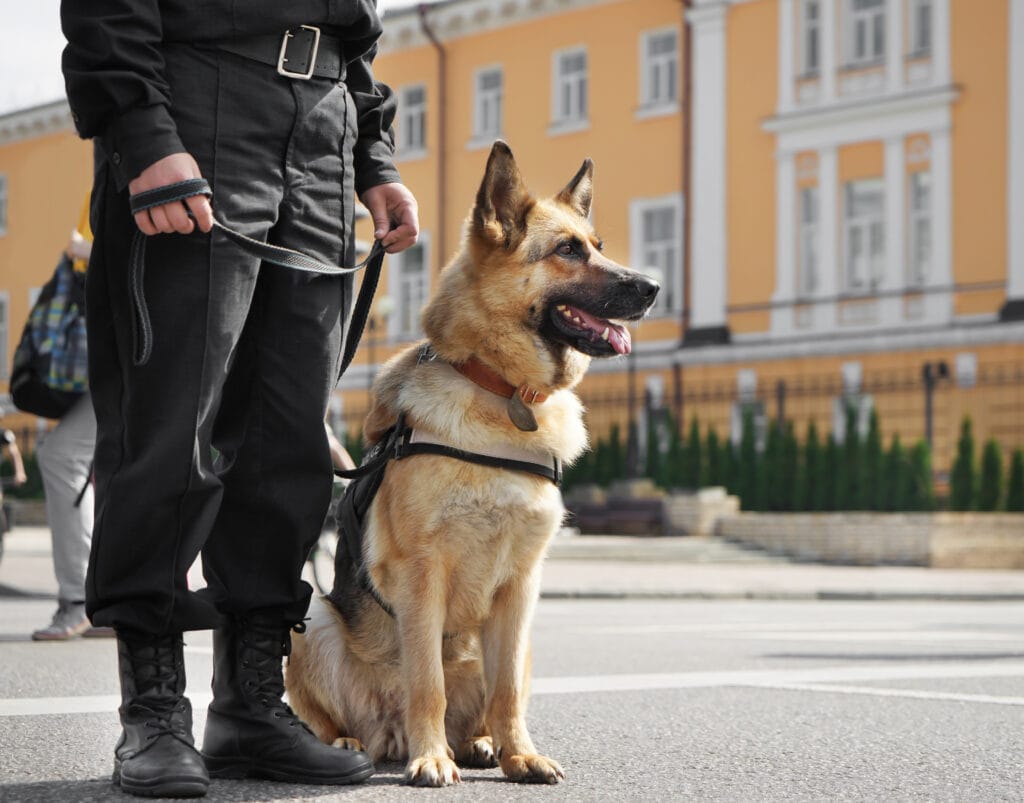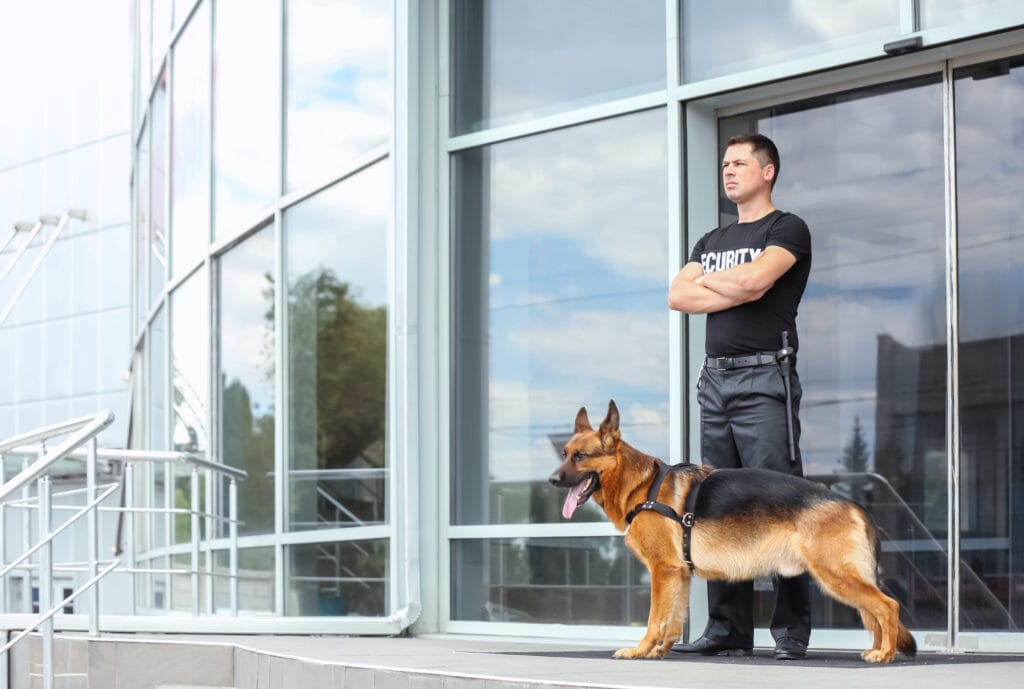German Words For Dog Training (Schutzhund)
By admin / January 8, 2023 / No Comments / Uncategorized
Training your dog in german is a challenge, that’s for sure.
Popularised by things like Schutzhund, IPO, and other bitesports, German cues can be heard from police dogs, to regular dog owners, and even professional dog trainers.
When training your dog, your first instinct is likely to use your native language for commands, but dogs can learn to associate any word with the command you’re asking for, no matter the language.
German training commants is a popular choice for many dog trainers and pet parents to use in dog training because of its association with popular German dog sports. Schutzhund, for example, is a popular German dog sport that tests a dog’s tracking, obedience, and protection skills. It’s much more common with a german breed (or belgian), and working dogs (think more protection dog or guard dogs work than service dog)
During war efforts in the early 1900s, there were also many dogs recruited and trained for police work and other war duties in Germany. This creates the phenomenal image of these precise, strong dogs (usually german shepherds) who were phenomenally in tune with their handler. Because of how successful these programs were, dog trainers across the world turned to the German language for dog commands, as though this in itself was the trick…

Luckily, the cue itself doesn’t matter when we’re training dogs (yep, even german shepherd dogs!), german dog training commands have the exact same effect as basic commands – oh and if you really want? You can totally train some cues in English and others in german (Yep, you can have a bi-lingual dog – or tri-lingual? Seen as they speak dog too!)
The Benefits of Using German Words in Dog Training
The primary benefit to using a foreign language, especially German, to train your dog is that it minimizes the risk of distraction when you’re in public.
There are many opportunities in day-to-day conversations for words like “sit” or “stay” to be used that have nothing to do with your dog. Hearing these phrases can be confusing for your pup, and it can make your training more difficult.
It’s far less likely to hear German commands in your everyday life, so when your dog does hear the word, they know it’s for them.
With the English language especially, it can also be difficult for your dog to pick out the subtle differences between words. German has sharp pronunciations that make each word distinct from the next.
German words can also make dog training more fun for you and your dog. They help keep you engaged in your pup’s training, which benefits your dog in the long run, and they can be fun to show off to your friends and family.
The Drawbacks of Using German Words
While training your dog using a foreign language like German has many benefits, it also means you’ll need to learn words in a new language before you can train your dog. This is a process that can take time and can be challenging for many people.
Having your dog know commands in a different language can also make it more difficult for you to leave your dog with someone else, whether that’s for a day at doggie daycare or a week with a dog sitter while you’re out of town.
For someone else to properly care for your dog, they will also need to learn and understand all the words you use for commands.
Also, because it’s not your first language, when your dog runs into the road, are you going to yell “STOP!” or “Halt!”? Sometimes the instinctive word is the right word.

List of German Dog Commands
If you’re excited and ready to teach your dog commands in German, here are 15 of the most common for you to try.
Sitz (Sit)
Sit is one of the first commands you teach your dog because it has many convenient uses for behavior training as well, like having your dog sit when company comes over so they can’t jump on them.
The German word is similar to the English pronunciation with an added “z” sound at the end.
Aus (Down)
Aus isn’t a literal translation to “down,” but the meaning is close to “knock it off” in English. This is another crucial command to teach your dog for other practical uses like teaching them how to relax.
Steh (Stand)
Pronounced like “sh-tay,” Steh is a natural command to teach while you’re also working on sitz and aus.
Stand works as a transition between commands, so you can reset your training, and it’s also an important piece of obedience training.
Stopp/Halt (Stop)
There will be many moments in your dog’s life when you’ll want them to stop what they’re doing, whether that’s to stop before crossing the street or to teach them boundaries in your home.
Stopp and Halt are both common interjections in German and pronounced similar to the English pronunciations.
Bleib (Stay)
Teaching your dog to stay is an important piece of impulse control training, and it can also be helpful for your dog’s safety. Bleib is pronounced like “Blibe.”

Fuß/Fuss (Heel)
A reliable heel is a great tool to keep your dog safe and focused while you’re out in public, especially with leash training. Fuss (pronounced foos) is a German word that means “foot,” meaning your dog should walk beside or behind your feet.
Hier/Komm (Here)
A reliable recall is another great safety tool to have in your dog training tool belt. Both “hier” and “komm” are pronounced similar to their English counterparts of “here” and “come,” and either can be used in your dog training.
Gib Laut (Speak)
Speak is a fun command to teach your dog, but it’s also a great tool to help curb unwanted barking at strangers. Gib Laut is a German phrase that translates to “give sound.”
Nein/Pfui (No)
Dogs are unpredictable animals, and “no” is a versatile command to keep your dog in control. Nein (pronounced like “nine”) translates to “no” in German, and pfui (pronounced foo-ey) is a common German interjection that can mean “eww” or “stop that.”
Braver Hund (Good Dog)
This is your marker word! Your Good boy, or good girl. Every dog needs to be praised and rewarded for their good behavior. In German, you can praise your dog with the phrase “braver hund,” pronounced like “brahfer hoond.” You can also give your dog treats, known as “leckerlis” in German.
Ruhig (Quiet)
If your dog is especially outspoken, teaching a quiet command is important to managing their barking. Pronounced “roo-ig,” this German command is perfect for pairing with the “Gib Laut” command.
Hopp/Hupf (Jump)
If your dog is an energetic pup, teaching them to jump can be a fun trick—and it’s also helpful for getting in and out of the car. Hopp is pronounced like “hup,” a common interjection sound for even English speakers to make.
Box (Crate)
If you’re working on crate training your dog, having a specific command for the crate is important. The German command is easy for English speakers to remember—it’s pronounced just like the English word “box.”
Bring (Fetch)
Fetch is a great way to burn your dog’s energy, and it can be an impressive command to show your friends. The German command is another easy-to-remember word for English speakers, as it’s pronounced like “bring” in English.
Voran (Search)
If your dog loves to sniff, nose work is a great enrichment activity. Use this command (pronounced for-ahn) to teach your dog how to sniff and search for specific objects or scents.

Should You Train Your Dog in German?
There are a variety of benefits to training your dog words in German, but it will depend on what training method works best for your dog.
Even if your dog already knows English commands, adding another layer to their training with a foreign language can be a great way to refresh a few of their skills.
Remember,
Training sessions should be short, german training commands may help you to dedicate that time, but remember, all dog breeds can learn in german, because all a training cue is? Is a common language with your best friend. The training process may be difficult at the best of times, but when it comes to obedience commands and cues the command words themselves do not matter. So long as you use it consistently.
Personally, I do think that german is a little excessive for the average dog, but hand signals? Those are suuuuper useful as a back up.
If you are struggling to get your dog’s attention, then changing language or adding in new words isn’t necessarily going to help you. Instead take it back, start with the essential commands and work on distraction, distance and duration.
Or, of course, if you’re struggling, feel free to reach out! I’m always happy to help!
Author, Ali Smith
Ali Smith is the Positive Puppy Expert, dog trainer and is the founder of Rebarkable. She is passionate about helping puppy parents get things right, right from the start. To help create a puppy capable of being a confident and adaptable family member and keep puppies out of shelters.
Ali has won multiple awards for her dog training, and has had her blog (this blog!) rated as 2021 & 2022 worlds’ best pet blog!
